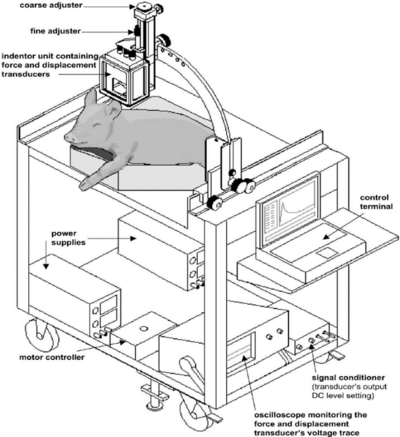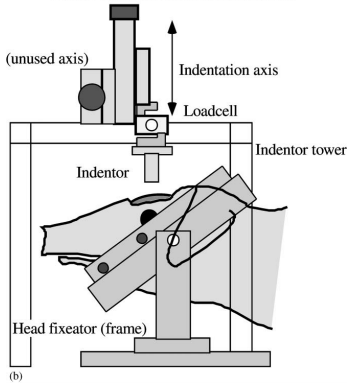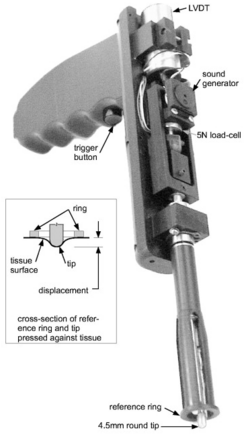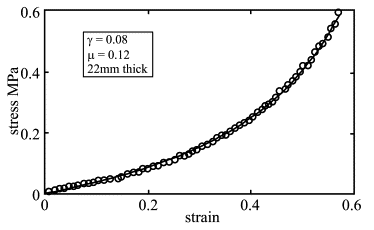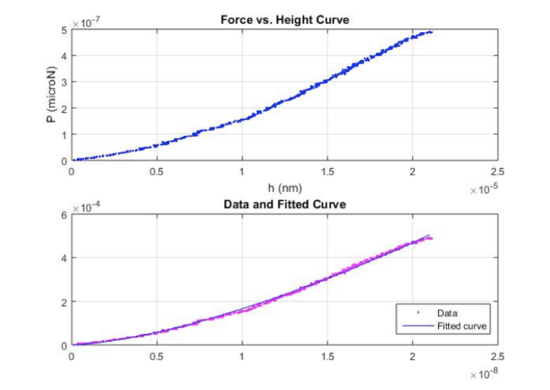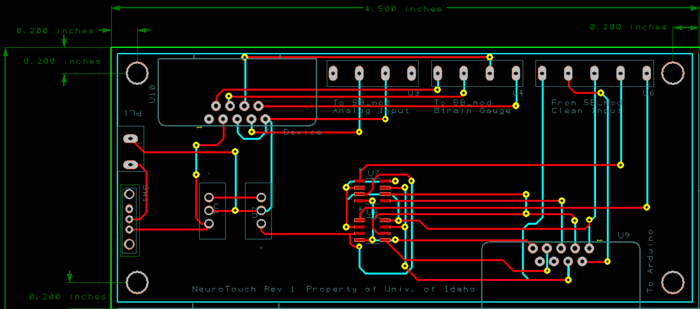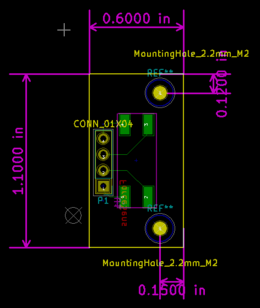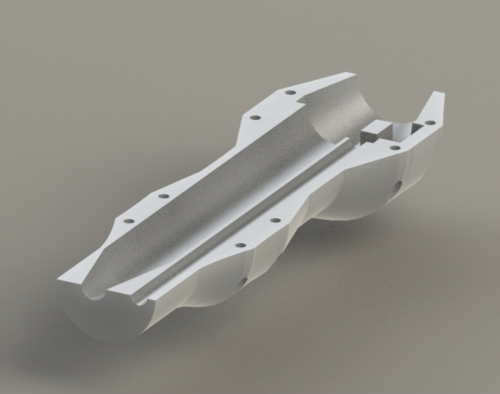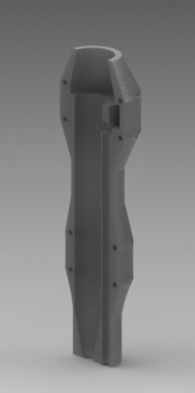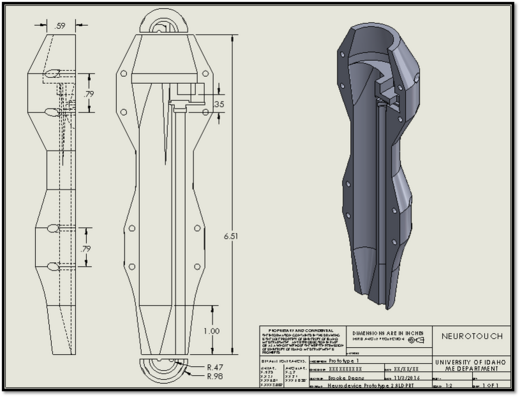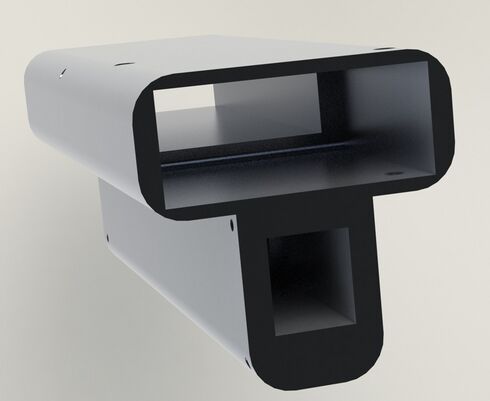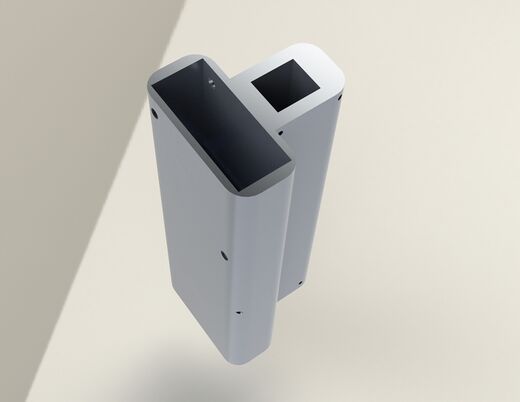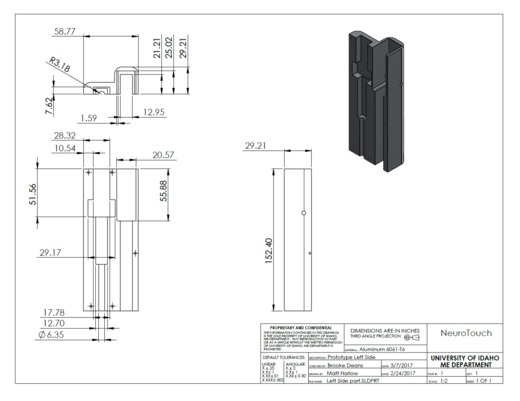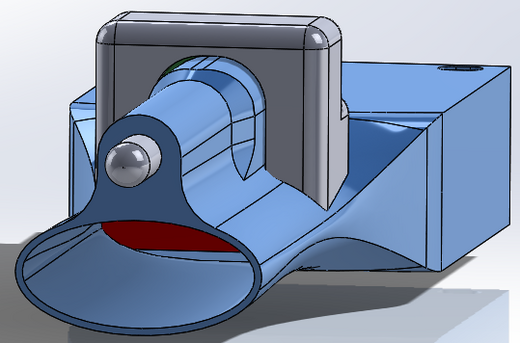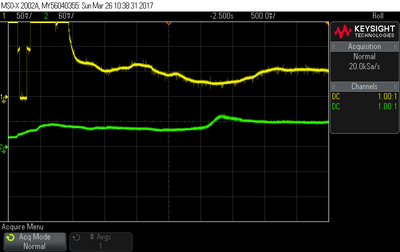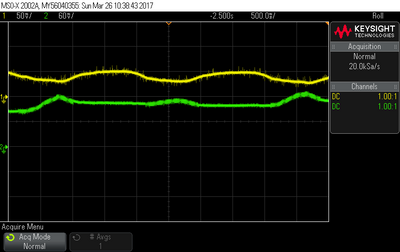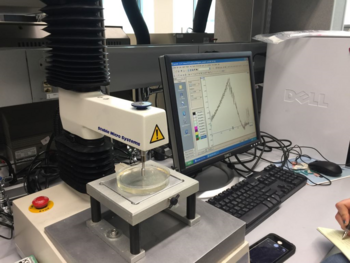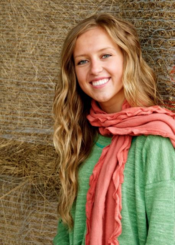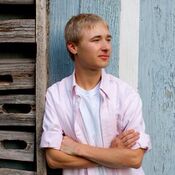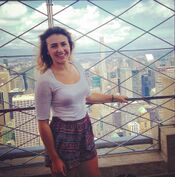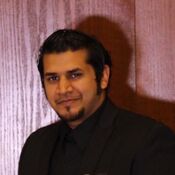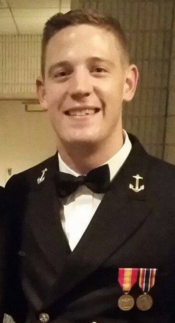Biological Stiffness Measurement
| Sponsors | Dr. Bryn Martin, Dr. Mike Maughan |
| Team Name | NeuroTouch |
| Duration | Fall 2016 - Spring 2017 |
| Faculty Advisors |
|
| Graduate Advisor | |
| Students |
|
The aim of the project is to design and develop a handheld device that can accurately measure the stiffness of a biological tissue, specifically a brain in vivo.
Problem Definition
Background
Currently doctors have just been using their fingers to attempt to get an estimation on brain stiffness for use as a symptom of a disease. Doctors can use magnetic resonance elastography (MRE) to obtain stiffness, but there really isn't a device in place to in a matter of moments determine biological tissues stiffness. Brain stiffness has been investigated increasingly as an indicator of neurological diseases, including Alzheimer's disease.
Specifications
| Specifications | |||||
|---|---|---|---|---|---|
| General Requirements | Specific Requirements | Target Values | |||
| Handheld | Create a device that can be held and maneuvered easily | Ergonomic to a user's hand | |||
| Ease of Use | Create a device that gives accurate measure of biological tissue stiffness | User can plug in device and use instantly with minimal setup | |||
| Operate in Small Area | Allow device to detect brain stiffness in small diameter hole in brain | End effector tip is 1cm in diameter | |||
| Quick Results | Device electrical sensors and components can relay data and compute stiffness on external display | Tissue stiffness displayed on monitor in less than 10 seconds, actual operations also less than 10 seconds | |||
Deliverables
- Concept sketches/CAD models of the device with sensors in place
- Final machined device
- Matlab and Arduino programs used to obtain raw data from sensors and send it to computation in order to establish a best fit modulus of elasticity
Project Learning
Previous Methods
While finding the elastic modulus of a metal can be done quite easily, our problem is finding that of a biological tissue which reacts very differently when an external force is introduced. There have been experiments performed to determine the elastic modulus of biological tissues, they are with devices that can't be made mobile, or devices that will either endanger the brain physically or through the introduction of foreign bacteria. Our findings on previous methods are shown below.
| Biological Tissue Stiffness Tests | ||
|---|---|---|
| Pig Indentation | Pig Apparatus Detail | Gun Device |
Biological Tissue
Biological tissue stiffness operates differently than that of metals, as seen in the figure below in which a pig spleen was tested.
We will be using a least-squares curve-fitting algorithm in order to map a best-fit curve to our force and indentation depth data points as seen below
Design Development
Mechanical Designs
| Device Concepts | |||||||
|---|---|---|---|---|---|---|---|
| Concept 1 | Concept 2 | Concept 3 | Final Concept | ||||
Electrical Hardware Designs
System Design: Processor(s) and Memory
The first revision of this project involved an idea of using a dual ported memory with two processors on either side. The first process would be involved with gathering the data and placing it within the memory. The second processor would focus on taking the information from the memory and calculating the elastic modulus from this information. It was then decided that due to the complexity of syncing two different processors over the same memory, it would be a better route of action to move towards a single processor solution.
The second revision involved consolidating this design down to a single processor as to lessen the amount of complexity of the system. The choices under consideration were Arduino (specifically the Arduino Uno) and the Raspberry Pi 3. Upon further research, it became apparent that communication with the General Purpose Input/Output (GPIO) pins of the Raspberry Pi would be best accessed via the bash terminal, and due to lack of experience with this method of interfacing, the team chose to utilize the Ardiuno Uno within their design.
System Design: Measuring Methods
Originally, the team looked on towards three different methods of distance measuring: photoelectric, ultrasonic, and laser.
Photoelectric sensors can produce accurate results when they are properly calibrated, but since their response is dependent upon the time taken from the generated signal to bounce off of the reading surface and back to the optical reading unit, a change in color of the surface can affect the reading. This means that for each color change, the photoelectric sensor would need to be re-calibrated. Since the NeuroTouch team was not entirely sure of a uniformly-colored surface for the brain, the decision was made to not utilize this type of sensing.
The second option for proximity sensing was the ultrasonic sensor. From the project learning research, it was found that ultrasonic sensing was very good for minute distances (on the order of <100mm) which is exactly the range that the device is specified to measure. Additionally, a representative from Balluff was able to provide the group with a sensor to experiment with. After some preliminary testing, it was found that over the range planned for the device (30-40 mm), there was significant noise on the output when making sub-millimeter measurements. The only solution to increase the precision of measurement would be to move the sensor closer to the tip of the unit, and even that would not guarantee an increase in accuracy. Thus, the team chose to utilize a third option of measurement reading: laser.
In a side-by-side comparison, it was shown that laser sensing can produce a more stable, consistent, and precise reading than the ultrasonic sensor, at both close (approx 10 mm) and medium (>40 mm) distances. This is the current proximity method used by the NeuroTouch team.
Additionally, a small force sensor (sensing 0 - 20 N, overforce of 60 N) will remain in contact with a metal rod in order to detect the amount of pressure exerted upon the soft tissue.
Illustration of Current Electrical Hardware Revision
| Electrical Hardware Designs | |
|---|---|
| Main PCB | Accessory PCB |
System Design: Noise Reduction
Within the design is contained two Dataforth SCM5B (further referred to as 5B) modules, officially titled as Isolated Analog Signal Conditioning Modules. These 5B modules serve two purposes within this design. The first is that these modules are guaranteed to reduce the noise of signals outside of the bandwidth by at least 60 dB. This will provide a very clean, clear signal for the Analog to Digital Converters (ADCs) to easily interpret. Secondly, these modules electrically isolate the system, so that any static shock will not be propagated through the rest of the circuit, causing damage to more sensitive components in the latter parts of the design.
Prototypes
| Midway Design and Renders | ||
|---|---|---|
| Render 1 | Render 2 | CAD Drawing |
The first design accommodated for a cylindrical ultrasonic sensor that was later eliminated.
| Second Design and Renders | ||
|---|---|---|
| Render 1 | Render 2 | Second Drawing |
This design was probably the bulkiest out of all of them due to the introduction of the large laser sensor into the design. We were constrained by this large sensor and realized later we could move it from being held with our hands.
| Final Design | ||
|---|---|---|
| Final Prototype | Cut in half | Bottom view |
The final design eliminates the laser sensor being held with the hand and provides for a pen like ergonomic grip on the device. A separate machined part seen above in silver was made in order to house the accessory PCB, which provides routing for the 4 leads coming out of the force sensor as well as providing a perpendicular area for the force sensor to sit on. This design is very comfortable compared to our other ones and is easy to assemble.
Testing Implementation
| Oscilloscope Data & Testing | ||
|---|---|---|
| Oscilloscope View | Force and Laser Sensors Working in Conjunction | Texture Analyzer |
In the pictures above you can see the output voltages of the force sensor in green and the laser sensor in yellow. As the distance decreases, the voltage goes down, and as the force increases, the voltage goes up. The texture analyzer is a device that is able to do similar functions as our project, only it wouldn't be able to be used in a surgical setting.
Team Information
Document Archive
- References

